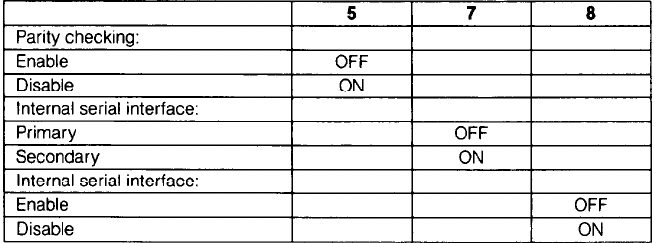
Table 1-2. Set 2 DIP switches
Switch 5 (parity checking,)-Parity checking is the method your com-
puter uses to detect any errors in RAM. If you enable parity checking
and the computer detects an error in memory, an error message displays.
For maximum protection, turn off switch 2-5 to enable parity checking.
To disable parity checking, turn on this switch.
Switch 7 (internal serial interface)--To use two serial devices (usually a
serial printer or modem), you need to designate the built-in serial inter-
face as either primary or secondary. In MS-DOS, you would then refer
to it as COM1 or COM2 respectively. To use the built-in interface as the
primary device, turn off switch 2-7. If you have not installed an extra
serial interface, the built-in interface is the primary device regardless of
how you set this switch. If you have installed an optional serial interface,
you can use the built-in port as the secondary device if you turn on
switch 2-7. You can then select any peripheral connected to the optional
port as the primary device.
Most option cards which contain serial interfaces have jumper connec-
tors which you must set to tell MS-DOS whether you are using the port
as COM1 or COM2. If you use the built-in interface as the primary
device, you must set the jumper on the optional interface to make it
COM2. If you accidentally set both to act as the primary device, you will
not damage the computer, but you will get unpredictable results from
both interfaces.
Switch 8 (internal serial interface)--If you connected a peripheral to the
built-in serial port on the back panel, turn off switch 2-8 to enable this
port. If you do not want to use the built-in serial port, turn on switch 2-8
to disable it. For example, you need to disable the built-in port if you use
an optional port as COM1 and a modem as COM2; MS-DOS can only
recognize two serial devices.
20


















